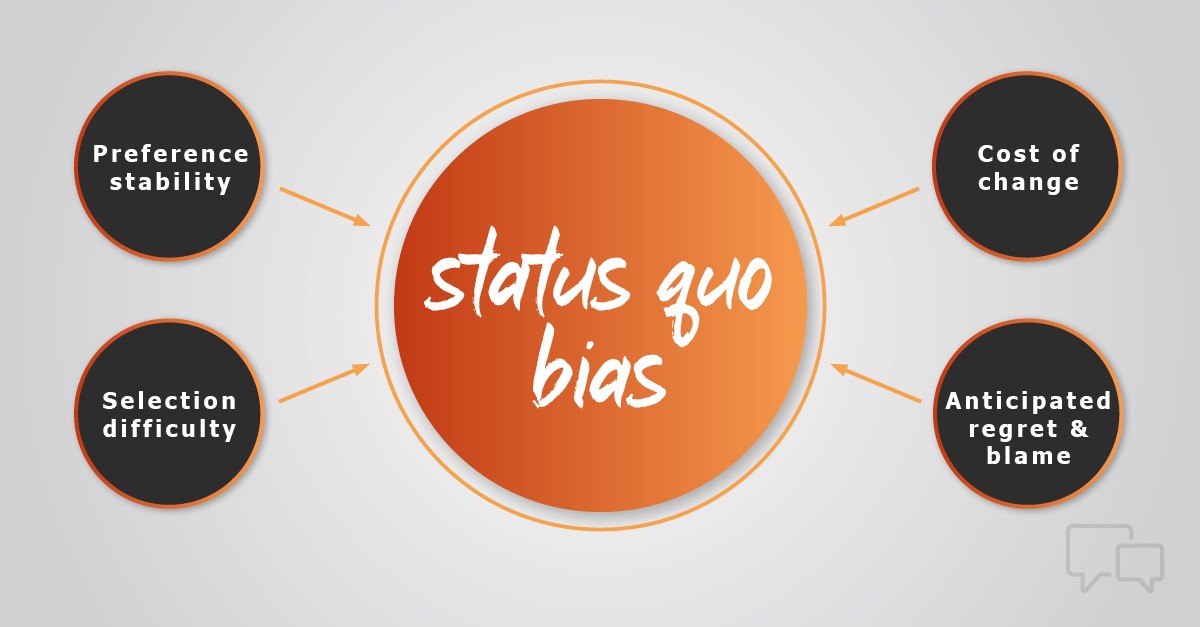The status quo bias is a cognitive bias that refers to our tendency to stick with the current situation or status quo. This can be due to a variety of factors, such as loss aversion (where we prefer avoiding losses over acquiring gains) or simply because it’s comfortable and easy to stay with what we know. The status quo bias can have a significant impact on our decision-making, leading us to make choices that may not be in our best interests.
We’ve all heard of the status quo bias before – it’s that innate human tendency to want things to stay the same. We like familiarity and we’re creatures of habit, so it’s no wonder that we often resist change. But what exactly is the status quo bias?
And why does it exist? Simply put, the status quo bias is our preference for things to remain unchanged. We don’t like feeling out of sorts or uncomfortable, so we often stick with what we know – even if it’s not necessarily in our best interests.
The status quo bias can lead us to make sub-optimal decisions in both our personal and professional lives. For example, you might stay in a job you hate because it’s familiar, even though there are other options available to you. Or you might keep using an outdated piece of software because you’re used to it, even though there are newer and better versions out there.
Inertia is a big part of the reason why we exhibit the status quo bias – it takes effort (and sometimes courage) to make changes in our lives, so we often end up sticking with what we have. But this isn’t always a bad thing – after all, if something ain’t broke, there’s no need to fix it! The key is to be aware of thestatus quo bias when making decisions, so that you can weigh up whether or not change is really necessary.

Credit: online.wharton.upenn.edu
Table of Contents
What is the Meaning of Status Quo Bias?
Status quo bias is a cognitive bias that dictates that we humans are more likely to stick with what we know, even if there might be a better option available. This tendency to prefer the familiar over the unknown can lead us to make sub-optimal decisions in many different areas of our lives.
For example, imagine you’re considering whether or not to switch jobs.
Even if the new job would offer higher pay and better benefits, you might still stay with your current employer because changing jobs can be scary and uncertain. The status quo bias leads us to value things like security and comfort over potential gain, even when making logical decisions.
Of course, there are times when sticking with the status quo makes perfect sense.
If something isn’t broken, there’s no need to fix it. But when it comes to important life choices, it’s important to be aware of this natural human tendency so that we can override it when necessary and make the best decision for ourselves.
What is an Example of Status Quo Bias?
Status quo bias is a cognitive bias that refers to our tendency to stick with the current situation, even if there might be a better option available. This bias can lead us to make sub-optimal decisions, because we are reluctant to change what we’re already doing.
There are many examples of status quo bias in action.
One common example is sunk cost fallacy, which occurs when people continue investing in something (time, money, etc.) even though it’s no longer rational to do so because they feel like they have too much invested already to give up now. Another example is confirmation bias, which is when people seek out information that confirms their existing beliefs instead of considering evidence that might disprove them.
People often fall victim to status quo bias without even realizing it. It’s important to be aware of this cognitive biases so that you can avoid making suboptimal decisions due to resistance to change.
Another example, let’s say you’re considering switching jobs.
Even if another job might offer better pay and benefits, you may be hesitant to make the change because it would require adapting to a new work environment. The status quo bias would lead you to stay in your current job, even though it may not be the best option for you. This bias can also impact our decision-making in other areas of life, such as when choosing which products to buy or which investments to make.
We may stick with what we know and are comfortable with, even if there are superior options available. Overcoming the status quo bias can be difficult, but it’s important to consider all of your options before making any decisions. If you’re struggling to break out of this cognitive trap, seek help from a friend or professional who can offer an objective perspective.
Another example of status quo is when a company does not change its policies or procedures, even though other companies in the same industry have made changes. The company may feel that it is unnecessary to make changes, or that the costs of making changes would be too high. This can lead to the company falling behind its competitors and eventually losing market share.
How Does Status Quo Bias Work?
Status quo bias is the tendency to stick with what we know, even if there are potential benefits to change. This bias can impact our decision-making in both small and large ways. For example, you may be hesitant to switch to a new toothpaste brand, even if it’s cheaper and works better than your current one, simply because it’s what you’re used to.
On a larger scale, status quo bias can lead us to stay in jobs we hate, relationships that are toxic or unhealthy lifestyles because we’re afraid of change. Change can be scary, but sometimes it’s necessary in order to improve our lives.
If you find yourself struggling with status quo bias, try thinking about the potential benefits of change.
What do you have to gain by making a switch? Would the new option really be so bad? In many cases, the answer is no – so don’t let fear hold you back from making positive changes in your life!
Conclusion
The status quo bias is a cognitive bias that dictates that people are more likely to stick with the current situation than change it. This often leads to suboptimal decision-making, as people are reluctant to leave their comfort zone. The status quo bias can be overcome by carefully considering all options and examining the pros and cons of each before making a decision.
